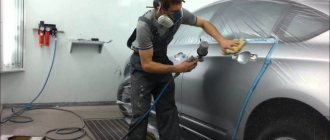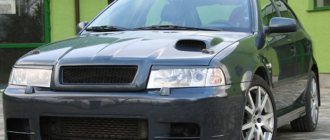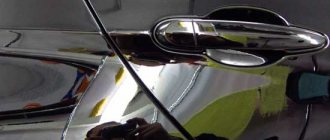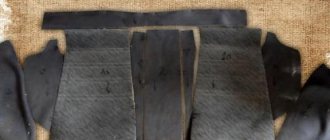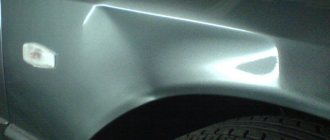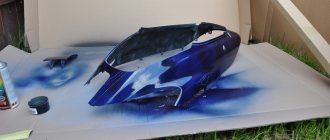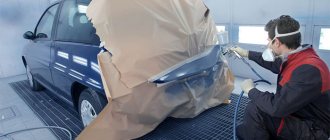Types of wood coatings - how are they chosen, what are they?
Wood is one of the best materials for the construction of private houses, finishing work inside residential premises, and the manufacture of various pieces of furniture and products used in everyday life. Natural wood has a chic appearance, is environmentally friendly, it breathes and retains heat perfectly. The service life of any wooden structures and surfaces directly depends on how well and correctly they are processed with special paints and varnishes. The latter must be selected taking into account:
- Types of wood used. Painting structures made of coniferous wood is done with one composition, and that of deciduous wood with another.
- Possibility of re-processing a wooden product painted with a specific paintwork material.
- Operating conditions of buildings and surfaces made of wood (high humidity, exposure to sunlight, and so on).
- Compatibility of the selected paint with coatings and primers applied previously.
- Methods for preparing products for dyeing.
As you can see, figuring out what to paint wood with is not so easy. Nowadays there are many different types of paints and varnishes on sale. They are divided into three main groups - transparent compositions, dispersion coatings, opaque enamels. The former refers to all kinds of impregnations, protective special glazes and varnishes without color. Transparent paints and varnishes are used to protect wood from ultraviolet radiation and emphasize the natural wood structure.
Dispersion compositions provide increased water and frost resistance, vapor permeability of processed products, as well as preservation of the color of the latter for a long time. The solvent for such paints and varnishes is water, and the binding component is alkyd resins, acrylates or synthetic latexes. The most famous representative of dispersion coatings is acrylic paint. She is extremely popular these days. Opaque enamels are traditional coloring compositions. They are easy to use, have good hydrophobic properties, and guarantee high quality processing.
In everyday life, wood painting is most often done with alkyd, oil and acrylic compounds. We will talk about the features of these paints in more detail.
Pros and rules of winter car painting
Painting the body or parts of a car in a garage or on the street requires compliance with certain conditions. In winter, selecting the required temperature can deliver
a lot of problems . However, paints and varnishes should be used within the temperature range indicated on the packaging.
If there is a need to urgently paint your car in winter, then after-sales service will solve the following main problems:
- Removing signs of wear.
- Carrying out urgent repairs.
- Hiding damage to the body.
- Updating the appearance of the car.
- Detailed painting of the structure.
Experts do not advise beginners to paint the body themselves. You can gain the necessary knowledge and experience if you start painting individual machine parts. Before carrying out work, you should remove all unnecessary objects from the garage and sweep away dust.
Painting taking into account temperature differences requires a step-by-step execution of work . The time interval between application of paint layers, indicated by the manufacturer on the packaging of the paint and varnish material, may be increased. The duration of the pause is usually 20-30 minutes .
To regulate the temperature in the garage, you can use various heat sources , including a gas gun, fan heaters or heaters. By heating the room in the morning, you can maintain the desired temperature throughout the working day.
As you continue to prepare your garage, you need to keep in mind that the car should be painted within a few days . The step-by-step painting process is due to the fact that it is impossible to paint an entire car yourself in a day.
To make painting easier, you must first remove the doors from the car body. Bumpers should be painted first after being removed from the car. At the next stage, you can begin painting the trunk and hood.
Oil compositions are slowly fading into oblivion
Oil-based paints have been used less and less in recent years. Their main producers are domestic companies. Foreign companies practically do not produce such paints. Oil mixtures contain drying oil. This additive makes paints toxic and unpleasant to smell.
Working with oil compositions is not very convenient. Firstly, they are applied exclusively in cool and completely dry weather. If there is a little rain outside, the painting process will have to be postponed. Secondly, these paints take at least 24 hours to dry. Thirdly, before applying the oil mixture you will have to work hard to prepare the wooden surface. It should be thoroughly cleaned and leveled. If you don't do this, you will end up with a poorly painted surface with streaks, bubbles and other defects.
In addition, it is impossible to apply another type of paintwork to paints with drying oil later (for example, when you need to update the product). If you treat wood with oil paint once, you will have to use it constantly. We advise you to think several times before choosing such compositions.
Ideal temperature for painting
Vehicles are painted in auto repair shops in paint booths, which provide the necessary temperature conditions for work processes. Such cameras have temperature sensors. Drying painted cars does not always require high temperatures. Such conditions are created for certain types of automotive enamels that come complete with a hardener. In order to obtain a wear-resistant, strong, durable coating as a result of applying such paint on metal, the vehicle must be dried in a special box that provides a +80 ° C regime.
The ideal temperature for painting a car is considered to be +18...+22 °C, and the maximum permissible temperature is no less than +15 °C and no more than +25 °C. The puttying process can be carried out at an ambient temperature of +20 ° C, since the putty will not harden in colder air. Some inexperienced car owners who carry out paintwork in an unheated garage during the cold season consider adding more hardener to the putty as a way out, hoping for the composition to harden. This is a serious mistake, since excess hardener will not react, as a result of which the strength of such putty will be greatly reduced.
Alkyd coatings - many advantages, but also many disadvantages
Opaque alkyd-based enamels are characterized by affordable cost and good water-repellent capabilities. They form a film of microscopic thickness on the painted surface, which preserves the appearance of natural wood. Alkyd enamels dry quickly. For this reason, they are unable to penetrate deep layers of wood. This is an undoubted disadvantage, causing the fragility of alkyd coatings.
An important advantage of such enamels is low vapor permeability. The painted surface under a layer of such paint does not change its characteristics under the influence of moisture. Experts advise using alkyd-based paints for structures that tend to deform due to exposure to water. Typically, wooden window frames and doorways are painted with similar compositions. They are also used for exterior decoration of wooden houses, since alkyd paints are not afraid of frost down to -25–35 °C.
Painting wood with an alkyd composition is not difficult. The composition fits well on any substrate. But here it is important to observe one condition - the surface of the product must be absolutely dry. If you paint wet wood, there is a 100% chance that peeling and blistering will appear on it. Drying time for alkyd paint is no more than 10 hours.
Last moment. Alkyd coatings are made from synthetic solvents, resins, various driers and other chemical additives. Such a motley composition causes a low level of environmental friendliness of the finished compositions. This means that it is undesirable to use them for work inside the house.
Applying the base coat of paint
In most cases, car painting technology involves applying two layers - a base layer and a finishing layer, which is a varnish that is resistant to atmospheric and abrasive influences caused by the presence of dust in the air. There are exceptions to this rule. Thus, the technology of painting a car with acrylic paint does not involve the use of varnish. However, some masters still use it to achieve better shine.
The technique of painting a car is to apply 3 layers without streaks or smudges. The first one is made thin - this is necessary to ensure good adhesion to the ground. The second is the main one, the thickest. It is this layer that is responsible for the even, uniform color of the surface. The third pass is done with liquid paint. The final thin layer provides gloss.
Acrylic paints are the leaders of the modern coatings market!
Many home craftsmen know exactly how to paint wood. Without unnecessary torment and searching for ideal compositions, they choose acrylic paint for processing wooden structures. It makes sense. Acrylic-based compositions:
- 1. Do not close wood pores (allow the wood to breathe).
- 2. They do not have an unpleasant pungent odor.
- 3. Retain their original color for a long time.
- 4. They can withstand frosts down to -30° without problems.
- 5. They have excellent water repellency.
- 6. Allows you to obtain any, even the most rare and unusual color shades.
Another advantage of such paints is their unique environmental friendliness. The binding element in them is non-toxic acrylates, and water is used instead of a solvent. Residents of European countries widely use acrylic enamels. Domestic consumers also began to care about the environment and their own health. Therefore, sales of acrylic compositions are increasing from year to year. And this despite the objectively high cost of such paints.
Working with acrylic paint is easy. It is easily applied to wooden bases using a sprayer, brush or paint roller, and dries quickly. And most importantly, the coating can be easily renewed at any time without the need for preliminary cleaning of the surface to be painted. For many home craftsmen, this property of paint is of great importance.
Important! Acrylic compositions almost instantly lose their properties when stored at subzero temperatures. Therefore, if you plan to paint wooden structures in winter, purchase the right amount of paint. Don't take it in reserve.
We hope you have decided which paint will be more convenient for you to carry out your planned finishing activities. It remains to figure out how to paint the wood. More on this later.
How much does it cost to paint a car?
The temperature of the room and paint affects the final result. If the temperature in the room where painting is carried out is low, after drying, tears of frozen paint may appear on the body of the machine.
A solution that contains too much coloring enamel will be very thin. The hardener can be used at a temperature of 20 - 23 ° C.
As mentioned earlier, to paint an ordinary passenger car, on average you need to spend 2.5 - 3 liters of paint. The larger the car, the greater the consumption, so an accurate calculation of the amount of product must be made per 1 square meter of vehicle. If you don’t know how much paint is needed to paint a car, you should calculate using the formula N = ¼/1 m2.
Where:
- N is the amount of paint required in liters;
- 1/4 is the required amount (per liter) for 1 m2;
- 1 m2 - body of the car to be painted.
Paint consumption when painting a car: car hood - 0.5 l, bumpers - 0.25-0.30 l, roof - 0.4 l, trunk - 0.3-0.4 l, radiator grille - 0.1 l , rear and front fenders - 0.5 l, sills - 0.15 l, car doors - 0.3 l.
Painting wooden surfaces - instructions to help novice painters
Painting wood correctly is not as easy as many people think. First of all, you need to qualitatively prepare the base for applying the paintwork of your choice. This procedure is always performed, regardless of what composition (acrylic, alkyd, etc.) is used. Remove old paint from the structure, clean it of dust and dirt. A used paint layer can be steamed with a construction hairdryer or removed using special removers sold in any modern construction store. After this, sand the surface, wipe it with a damp cloth and wait until the wood dries.
The next stage of wood preparation is degreasing. This operation can be performed using acetone or white spirit. If there are chips, visible scratches, or cracks on the wooden base, they should be removed with a spatula, and then the treated surface should be thoroughly puttied. Wait for the putty composition to dry. And then go over the wood with sandpaper.
Seal the parts of the wooden structure that do not need to be painted with tape. Now you can start the main work. To paint any tree with a brush or roller, do the following:
- dip the brush (roller) into the container with paint by a third;
- make short strokes along the surface along the wood fibers;
- After applying the first layer, wait for it to dry and repeat the procedure described above.
It is more convenient to paint large structures using a spray gun. And openwork wood products are usually treated with aerosol paints from spray cans. In these cases, the composition is sprayed approximately 0.25 m from the surface. The paint is applied in several layers. After completing all work, it is recommended to treat the painted wood with a protective varnish (for example, acrylic). Good luck to you!
Wooden floors, doors, windows - they all periodically require repair and painting. Instead of calling a specialist every time, you can prepare for this work and do it.
To paint a tree you need:
- painting material;
- brush;
- putty;
- primer;
- putty knife;
- construction hair dryer or chemical cleaner;
- sandpaper.
Stages
Selection of painting material
There are many types of wood paints and varnishes available on the market in various shades, degrees of transparency and gloss. Choose the covering material depending on the type of wood and the design of the room.
Oil enamels are suitable for all types of wood (including resinous ones). They are good for covering rough surfaces, since these enamels are highly wear-resistant.
For cosmetic repairs, use acrylic enamels. They are water soluble and less wear resistant than oil based ones. They do not have such a pronounced shine. Acrylic enamels dry quickly and are suitable for all types of wood (except resinous).
To obtain a transparent coating, use varnishes - oil-based or water-based polyurethane. The former are more wear-resistant, but water-based ones dry faster. Varnishes can also be tinted, with the addition of stains.
Prepare equipment for painting
Choose a brush. If you are working with small details, stock up on small brushes. To polish the surface you will need sandpaper, preferably fine sandpaper.
Prepare the surface before painting wood
If there is already one or more layers of paint on it that is peeling off and does not adhere well, it is better to peel it off. To do this, use a hair dryer - under its influence the old paint will peel off; remove it with a spatula.
Cleansing
Instead of a hairdryer, you can use chemical cleaners (leavers). After the chemical cleaner, wipe the wood with vinegar and clean water to neutralize any alkali that has formed. If the old layer of paint is relatively smooth and adheres firmly, putty can be used. After this, remove dust from the surface - wipe with a lint-free cloth.
Puttying
Often wooden surfaces require puttying. To ensure that the paint lays evenly, repair defects, scratches and holes, if any. Use putty, smooth it out carefully so that there is no need for sanding later. Better take a thin brush. Keep in mind that once the putty hardens, you will no longer be able to level it perfectly.
Removing irregularities and holes
To seal large holes, use construction foam, and the excess can be cut off with a knife once the foam has hardened. If there are small uneven areas, sand the surface with sandpaper. Coat the putty with drying oil before painting to avoid cracks.
Padding
You can prime the surface immediately before painting (although this is not necessary). A primer is advisable, especially when the surface is uneven. A primer is an impregnating material that forms a uniform film on the surface. It seals pores, glues dust, reduces the consumption of varnishes and paints, and extends the service life of wood. Apply one coat of primer and wait at least two hours before painting.
Painting
Start painting. Run the brush over the wood several vertical stripes, each time re-dipping it into the paint. Spread the paint over the surface. So color it all.
To protect yourself, wear a respirator and gloves, especially when working with a hair dryer and chemical cleaners.
Start work in the morning, in good light.
2148 0 0
Wooden facades are extremely popular due to their environmental friendliness, attractiveness and reliability. Sooner or later, owners of houses with similar coatings are faced with the question of painting the facade. Today I will tell you how to do this and what nuances should be taken into account in the process.
Is it possible to paint a car in a garage?
Is it worth the risk and start painting? Considering the disadvantages of garage conditions, truly high-quality coating can only be done with good experience. Painting in a garage has many differences from carrying out the procedure in a special chamber, where all conditions are provided. Professionals do not advise beginners to take on such a complex task or to first study in detail all the features and specifics of the work.
Differences between painting in a garage and painting in a special chamber
The differences between the two types of painting are primarily in cramped conditions. In a regular garage box there is no space for conveniently laying out materials and tools. The time for preparing the room and the painting procedure itself will be longer, therefore, there is a higher risk of disrupting one of the stages. It is difficult to create a constant temperature in the garage - there is a draft from the door, the heat is distributed unevenly, so car paint dries unevenly quickly.
Another important difference: it is not possible to maintain perfect cleanliness in the garage - dirt, dust, hairs, and other particles can get on the painted parts. You will have to first remove from the room everything that could harm the paint. It will take even longer.
The lighting problem is no less important. Garages rarely have high-quality lighting installed, so in one part the lamps shine stronger, in others there is a shadow, and visibility is worse. Making an even, high-quality coloring will not be easy. You will have to bring additional lighting sources, otherwise the quality will suffer.
The lack of an exhaust hood is no less unpleasant, since in winter a cloud of paint and varnish will irritate the respiratory tract. Microdroplets will not allow you to see well; they will settle on the surface and spoil it. The same sediment settles on the painted parts of the car; they will have to be additionally sanded. To create a high-quality coating, you need supply and exhaust ventilation in the room.
About the need to paint facades
The first thing that comes to mind when thinking about the need to paint facades is the decorative component. Still, painted surfaces look many times more impressive than untreated ones. But in addition to aesthetic qualities, there is also an important practical point.
Painting wooden products and facades allows you to:
- protect the wood from moisture, swelling and rotting;
- extend service life;
- prevent damage to surfaces due to insect pests.
As you can see, there are more than enough reasons to paint your house. But before moving on to considering the features of the process, I propose to understand the most popular types of wood that are used for the facade of a house:
| Type of wood | Peculiarities |
| Thermowood | A practical material that allows not only to decorate the façade of buildings, but can also serve as a material for creating ventilated facades. |
| Larch | A non-rotting material, which, however, is subject to deformation over time. |
| Pine | One of the most popular options that can be easily processed. The main disadvantage is that pine has a relatively short service life. |
| Oak | Incredibly beautiful textured wood with high strength. |
| Ash | Material with a beautiful pattern and very high strength. It is highly susceptible to spoilage, so regular processing is very important. |
| Red tree | Combines excellent technical characteristics and exquisite structure. |
Ambient temperature in the workplace
Temperature is a very important parameter for any paint and varnish material.
Minimum film formation temperature
For each coating material there is a minimum film-forming temperature, below which the resin particles are not able to combine with each other in the best possible way. Material applied at low temperatures may appear whitish, and the physical and chemical resistance of such a coating will be extremely low.
Maximum temperature when applying paints and varnishes
If the maximum temperature is exceeded, paintwork materials cannot be applied, since the processes of drying and film formation in the paintwork material will not occur as expected.
If the temperature in the spray booth is too high, the paint droplets may dry out too much before landing on the surface, which can lead to the formation of a rough paint film and poor coating adhesion.
In practice, it is very difficult to change the ambient temperature in the spray booth due to the constant exchange of air with the outside environment. It is much easier to regulate the temperature in the drying chamber, where air changes occur much less intensively.
Painting facades in 3 stages
If you want the wooden facades of your home not only to look attractive, but also not to deteriorate for a very long time, you need to approach the process with all responsibility. Painting the surfaces will go through several stages.
Stage 1. Selecting paint
Today the market offers a huge range of painting compositions for wooden surfaces. They can be:
- transparent or opaque;
- matte or glossy.
The type of paint should be selected not only based on personal preferences, but also according to the instructions given for each type of coating. Based on their chemical composition, coloring substances can be divided into the following groups:
| Photo | Type of coverage |
| Acrylic paint One of the most popular options for painting facades. Among its main advantages are:
| |
| Alkyd This type of wood coating has:
| |
| Polyurethane Has increased wear resistance, elasticity and heat resistance. | |
| Oil paints This type of coating is used less and less for finishing. The thing is that oil paints are toxic and take at least a day to dry. In addition, if painted carelessly, they leave behind stains. | |
| Water-dispersed This type of paint can be divided into two groups:
|
Regardless of how correctly you followed the painting rules, and how high-quality the coating was chosen, do not forget that the service life of the exterior decoration is limited. For transparent compositions it is 5-7 years, for opaque ones 9-10.
Stage 2. Surface preparation
Having decided on the type of paint, you should think about preparing the facade. This is a very important stage, on which not only the appearance of your home will depend, but also the shelf life of the coating.
The surface preparation technology before painting consists of several important nuances:
- If the surface has already been painted with other compounds
, the previous layer of paint must be removed. This can be done using a scraper or a brush with metal bristles.
- Be sure to sand the surface
with sandpaper and remove sawdust and dirt from the wood. - If there is resin on the tree,
remove it with a solvent. The gaps between the branches should be sealed with a special wood putty.
- Treat the surface with wood primer
. Most modern compositions contain antiseptic impurities that help protect the wood from damage. - Leave the façade to dry.
In dry weather this will take approximately 5-7 days.
Stage 3. Painting
Painting is the final and fairly simple stage that does not require any special skills. It is enough to follow a few rules.
As a rule, old doors have a high-strength panel and a high-quality frame, but the appearance deteriorates over time due to the thick coating. One of the low-cost renovation methods is using regular paint for wooden doors. In this material you will learn how to paint wooden doors and get acquainted with other modern methods of renovating the coating at home.
Rice. 1. Door before and after painting
Car body painting
You can achieve high savings by choosing colors that are similar to the color of the car before it was repainted. A full car repaint will require more coats of paint than a simple tint change. If you want to restore the color of only the damaged part, it will be much cheaper than completely repainting the car.
Selection of paints and varnishes
Paintwork materials are classified according to the following criteria:
- By composition (water and organic based);
- By protective effect (against organic and chemical substances, mechanical influences, changes in humidity and temperature);
- By method of use (internal, external, combined);
- By type (impregnations, paints, stains, varnishes).
1. Paints. Can be used to process new and old doors.
There are no difficulties in choosing, but due to incompetence people choose the wrong material. Paint and varnish compositions can be transparent or opaque. The first compositions include certain pigments that exhibit the woody structure. But opaque coatings consisting of organic solvents (oil, alkyd and other types) are often used.
The most popular is alkyd enamel, the cost of which is affordable. This coating is highly durable and has a wide range of shades.
.
But the enamel smells bad, its unpleasant odor remains for 2 days, so they work with it outside, first removing the canvas from the hinges or vacating the room. An alternative solution is acrylic enamel, which also has many colors but does not have a toxic odor. Dried paint does not have much strength, so it is additionally treated with acrylic varnish to protect it from mechanical stress. Rice.
2. Wood paint A more durable coating for wood doors is nitro paint, which has optimal strength. The composition is toxic and sometimes leads to allergic reactions, so you need to wear protective equipment when working with it. If an old surface is treated with nitro paint, the panel is prepared and sanded in advance to a light shade.
2. Varnishes. They are traditional coatings that add shine to wood and protect its surface.
Typically, varnish is used to coat doors in rooms with high humidity (baths and saunas).
There are many different varnishes:
- Acrylic. The material is resistant to negative influences, humidity and ultraviolet radiation. There are matte and glossy finishes without a toxic odor.
- Nitrocellulose. Wooden doors can be treated with varnish. The coating is not suitable for treating bathrooms and saunas, as it has insufficient strength and cracks quickly.
- Water based varnish. It has no unpleasant odor. Due to different additives, the properties of the material may differ.
- Polyurethane. The varnish has high strength and adhesion to wood, and comes in matte, semi-gloss and glossy. In addition to wood, polyurethane varnishes can be applied to parquet, veneer, and countertops.
- Oil varnish. There is no pungent odor. The composition contains a lot of fatty resins, so the old coating is removed from the door in advance. It is better to apply with a brush due to the thick consistency.
- Polyester. The composition has a pungent odor, is highly durable, but is toxic, so it is suitable for treating street doors.
It is better to paint interior doors with acrylic or polyurethane coating, and resistant materials are suitable for external work or rooms with high humidity
.
Rice.
3. Wood varnish 3. Stains. The purpose of such compositions is to tint the wood and provide temporary protection from negative influences. But it requires constant updating of the layer that emphasizes the wood structure.
There are several options:
- With a varnish base (azure). The composition reduces the duration of work, but aesthetics are difficult to achieve, so a single-color surface can be obtained by spraying with a spray gun;
- With oils. Must be diluted with solvent before use;
- With water. It takes longer to dry, but there is no toxic odor. The composition penetrates deeply, giving a more saturated shade and a clear pattern that looks beautiful;
- Alcohol based. It dries quickly, but is more expensive and has a strong odor.
Fig.4.
Wood stain for a wooden door To protect the wood from fungus, moisture and dirt, oil wax is used, which penetrates deeply into the surface. The coating adds strength and shine
.
If you are choosing what to stain the surface of the door with, then you need to take into account the drying time and the resulting effect.
Preparing the canvas for painting
First, the door is removed from its hinges and placed on a flat surface. Before using alkyd paint, it is better to place the canvas outside or in a well-ventilated area. The door is then locked so that all elements are accessible. The fittings are also removed or wrapped in foil, and the locks are sealed with tape.
Cleaning the door
Preliminary cleaning and removal of old enamel or paint are carried out
.
For such purposes, it is better to use a grinding machine, and if you don’t have one, you can peel off the layer with medium-grain sandpaper. Any bubbles that appear are eliminated with a hairdryer, which heats up the paint layer to remove it with a spatula. A cost-effective and simple way to clean surfaces is with stripping compounds. Rice.
5. Cleaning and sanding the surface Layers of old paint can be removed with an abrasive attachment on a drill. Pieces of dust and paint are swept away from the panel, the surface is sanded so that there are no scratches, unevenness or roughness. The surface is inspected from both sides, the density of the joints is analyzed, and the frame can be strengthened with fasteners and metal corners.
Puttying and sanding
Existing cracks and gouges are filled with new putty.
.
For alkyd paint, a composition of any color is suitable, and before applying oil impregnation, varnish or wax, the tone of the putty must match the panel. Dried areas of the door are sanded with fine-grained sandpaper. At this stage, any defects are eliminated. Rice. 6. Door putty
Antiseptic coating
When applying paint, the surface is pre-treated with a fire retardant and antiseptic impregnation (for example, biotex) when the door is installed in a steam room. It is advisable to choose products from the same company, which will improve interaction and quality of coverage.
Rice. 7. Antiseptic for wood
After this, the door needs to be primed, and then a layer of putty must be applied. All areas of the door need to be treated, as well as cracks in decorative parts, between the jamb and the lintel. After the putty has dried, the surface is puttied again.
Dyeing technology
If you are painting a new canvas, you should protect it from swelling. First lay it on a flat surface and sand it with sandpaper or a sander. Then the panel is primed, the recesses and smooth areas are processed. After the surface has dried, secondary treatment is carried out.
Rice. 8. Directions for painting the canvas
An old house door needs to be painted with high quality so that there are no stains or smudges on its surface. It is unlikely that you need to buy a spray bottle to paint one or two canvases, so you can use a paneled brush or roller.
After you have chosen what you can use to paint a wooden door, you should familiarize yourself with some of the nuances of the work:
- fluff the brush, removing poorly fixed hairs;
- You need to paint a panel door correctly in 3 stages, using a roller, from the upper left corner you need to move to the right, covering the entire canvas. After drying, the door must be processed in the longitudinal direction. Then you need to paint the canvas from the upper right corner;
- When processing paneled fabric, you need to use a brush and treat the surface carefully, avoiding excess coating.
Rice. 9. Sequence of web processing
Painting with alkyd enamel
To coat doors with alkyd enamel, the following steps should be followed:
- remove the panel from the hinges so that paint drips do not appear on the surface. Then use a spatula and sandpaper to remove abrasions and the old layer, thoroughly rinse the surface and inspect for defects. Chips and cracks are puttied, the surface is dried and sanded. At the last stage, priming is carried out;
- the finished canvas lies on a horizontal surface of the floor, table or workbench, covered with polyethylene. The existing glass is sealed with tape. For a paneled door, first paint the panels with a brush, and then the protrusions. Subsequently, the entire panel is painted with a roller. With a two-layer application of alkyd enamel, the result will be a consumption of 40-80 g/m2;
- Additionally, you can tint the wenge fabric by impregnating it with a special compound. This paint is based on natural oils. After a layer of paint has been applied, you need to run it over it with a rubber spatula or sponge about 10 times;
- you can take liquid soap with paint. First, the panel is covered with paint and liquid soap. You need to apply another layer of coating to the soap.
Rice. 10. Alkyd enamel for treating wood surfaces
Stain treatment
When choosing a stain, no primer is used. The product penetrates into the deep layers of pine or oak wood, coloring its fibers and increasing its protective properties. There are several ways to apply the composition: rubbing, spraying, simple application and staining with a brush. Usually simple application is used
.
Rice.
11. Treating the canvas with stain Since the stain will adhere better to a damp canvas, it needs to be slightly moistened. First, coloring is carried out along the fibers, and then across them. We perform the next layer in the direction of the fibers. We process the panel with jambs from below so as not to disturb the design of the structure.
After the water-based stain has been applied, the surface should be sanded using sandpaper (due to raised fibers), remove dust and apply the next layer of coating. If an alcohol stain is used, the fibers will not lift and no sanding is required. But aqueous formulations do not have an unpleasant odor or toxicity.
Oil or wax impregnations
There are nuances to processing canvas with oil impregnation. First, the Pinotex composition is mixed well. If applied incorrectly, darkened areas and streaks may appear. For work, use a brush, sprayer, roller or foam sponge. Depending on the porosity of the material, the number of layers will be calculated.
Rice. 12. Application of wax impregnation
First, take a little composition, distributing it evenly across the width of the panel. Then the impregnation is rolled out with a roller or rubbed with a brush without sagging. Drying time is 8-12 hours. No later than a day later, another layer is applied.
Wood imitation
To ensure that you paint interior wood doors with your own hands correctly, follow the instructions:
- apply light paint (beige, white, gray or yellow) to the building material;
- treat the dried surface with liquid soap;
- cover with dark paint, remove liquid soap.
The wood structure can be created on veneered material by treating the fibers with a special brush (an antique effect is obtained). Then you need to apply one or more paint coatings to the surface and sand it.
